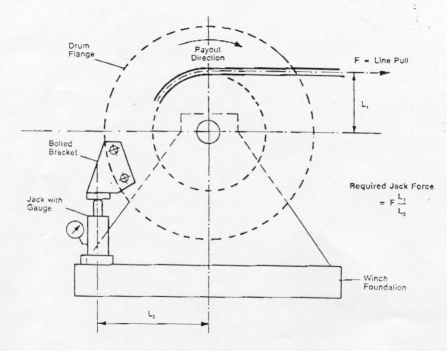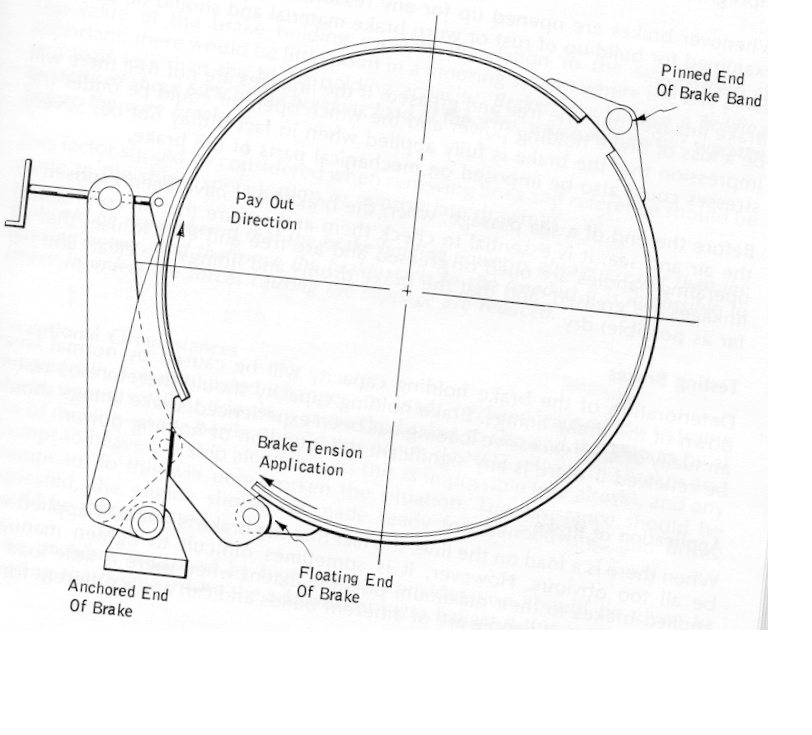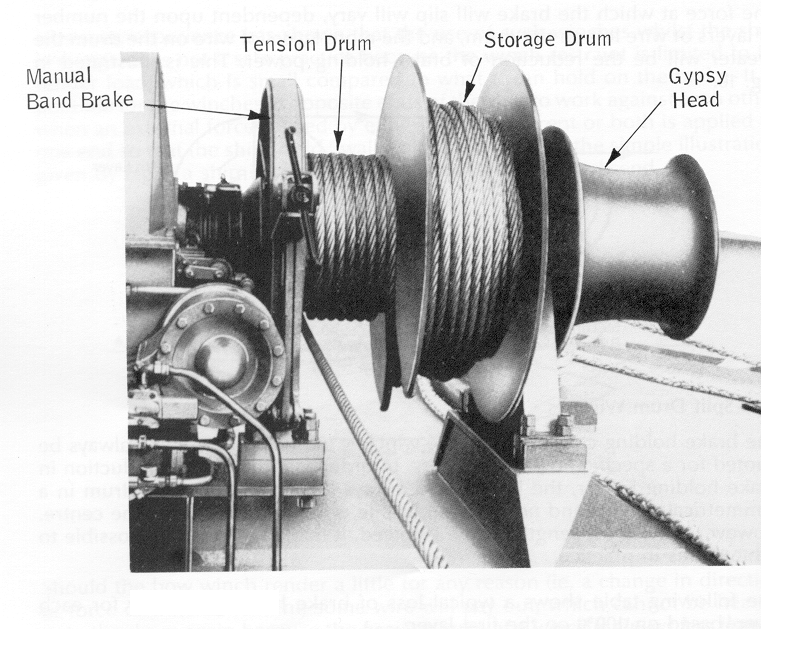

![]()
![]()
LOSS PREVENTION
Stephen R. Knapp IEng AMIMarE
MOORING WINCHES
In recent years the number of incidents involving large vessels breaking away from their moorings does not seem to have declined markedly. The potential for loss of life and damage to the environment, particularly where oil tankers are involved, is high with this type of casualty. We examine below some aspects of mooring winch operation and maintenance that we have commonly found to contribute to such casualties and the steps that can be taken by both ships' crews and shore management to maximise the performance of winches. Mooring winches come in a variety of designs. The choice of type is market driven and for this reason we see more electro-hydraulically operated equipment employing a simple band brake, which is applied by tightening a hand wheel to a predetermined torque, this being the cheaper option. The band brakes used are of the "positive servo" type. When additional load is applied to the attached mooring line, the band will stretch and the tightening mechanism becomes looser. In effect, if the wire/rope on the mooring winch has been pulled in by means of the hydraulic winch motor to the normal tension and the brake set to the maximum allowed tightening torque, there may not be available the maximum brake holding capacity. If wire tension increases, as a consequence of changing draught, current or wind, the operator will have to once more apply the recommended torque to the hand wheel, which will have become loose as a result of the increased tension in the mooring. He will not, however, be aware, necessarily, when the maximum holding capacity is reached and continued tightening may lead to the mooring line breaking before the winch brake slips. This is undesirable from the standpoint of personnel safety. Winches are available with spring operated torque applicators, these automatically apply the correct force between the brake band and winch drum at all times. This has the advantage that, once set, there is no requirement for a crew member to periodically re-apply the recommended torque. In such cases the brake is commonly released by means of a hydraulic lever. A typical design is shown in Fig. 1 below. Fig. 1 During service, brake linings and drum surfaces deteriorate in the salt laden atmosphere. Brake lining materials absorb moisture and soften, reducing their design coefficient of friction and thus the point at which slippage will occur at any given loading. Reputable manufacturers allow for this inevitability in the design of their materials and mooring winches by including a factor of safety, nevertheless, it is recommended that brake bands be regularly inspected. Running the brake drum slowly while introducing sand between the brake and drum is one way of removing loose/soft brake band material and roughening the exposed surface to maximise the frictional characteristics of the lining. It also assists in the removal of any loose scale that has formed on the brake drum as a result of its exposure to the elements. The operation should be carried out with care so as not to cause significant wear to the linings. Brake lining materials have been found to differ significantly depending on their origin. This continues to be the case despite mooring winch manufacturers' efforts to ensure that certain important criteria are met before the products are fitted to their equipment. It is perhaps surprising to note that there are no international standards or agreed methods available for testing the coefficient of friction for winch brake linings. In practice, this means that a single sample of brake lining may possess different frictional coefficients depending on where it was tested. This is not a situation that is likely to provide much comfort to Owners and their Insurers. In our view, it is worth the small additional expense to ensure that the quality of brake lining used is not substandard. Experience has shown that materials obtained directly from established European manufacturers, such as Ferodo, are unlikely to be troublesome, whereas "equivalent" products from some Far Eastern sources have been found to fall short of expectations. This important component should, where possible, be sourced directly from a known specialist supplier. In the event that the vessel is later involved in a mooring incident it will be infinitely more difficult for a Port Authority to substantiate any claim that the ship's mooring equipment was defective if high quality material has been utilised. Frequent testing of a vessel's mooring winch brake efficiency is a useful indication of the likely performance over any period. Tests are ideally carried out twice per year but once per year should suffice. The results of such tests should be carefully documented and filed. In the event of a mishap they provide powerful contemporaneous evidence of the operating efficiency of the mooring equipment. Testing is performed with an ordinary hydraulic jack with a pressure gauge and a bracket specifically made to bolt onto the flange of the winch drum, in order to transfer the jack force to the drum. The hydraulic jack substitutes for the pull in the mooring wire in order to apply a high and known load. The formula to compute brake holding capacity is given below and simply compensates for the difference in radius between drum and barrel (first layer) and the jack attack point, referred to drum centre. F1 = F2 x A/B F1 = Winch Brake Holding Capacity F2 = Jack Force = Jack press. reading x Jack piston pressure area A = Distance from drum centre to jack B = Distance from drum centre to centre of wire (1st layer) The arrangement for testing the mooring winch might look similar to that shown in Fig. 2 below. Fig.2 It is well worth experimenting during these tests to see what actual force is required at the winch brake handle to achieve the necessary brake holding capacity. Seafarers come in different sizes and builds; the chances of any given winch brake being consistently tightened to the optimum force is remote. If, however, the ship's crew are aware of the importance of this adjustment and have some yardstick (e.g. torque mechanism) to work to, then more efficient and safer mooring will result. It is also fairly straightforward to calculate the coefficient of friction required of the brake bands for any particular line load. Existing mooring arrangements aboard large vessels can be assessed, relative to their design loading and the brake band material characteristics. This can often show a much reduced safety factor when worn, damaged or substandard linings are in use. In general, mooring winches on large vessels are of the static kind and do not, therefore, suffer significant deterioration through relative movement between the brake bands and drum over time, unless repeated overloading of mooring lines has occurred. Fitting the correct number of winches and suitable linings initially should ensure a relatively low maintenance effort over the life of the ship. It is not intended that all aspects of correct winch operation be addressed in this note but rather to heighten awareness of common but seemingly little known factors that have in the past had severe consequences for Owners and Insurers alike. It is perhaps helpful to briefly summarise those elements of winch operation that are routine but, nevertheless, crucial if problems are to be averted.

The following diagrams illustrate the correct feed out for a winch wire and a typical arrangement of a split mooring winch drum.

Correct Payout Direction

Split Drum Winch
In the event that a vessel does suffer a mooring breakout the investigation into cause will be greatly assisted if the following points, in relation to the winch evidence, are adhered to.
The following lists areas requiring special attention when purchasing, operating or maintaining mooring winches for large vessels.
SEC
60 Knots wind from any direction simultaneously with either;
or
3 Knots current at 0 degrees or 180 degrees
or
2 Knots current at 10 degrees or 170 degrees
or
0.75 Knots current from the direction of maximum beam current loading
The above comes from experience gained as a result of involvement with a number of break out cases and whilst far from exhaustive it is hoped that these points will be helpful in avoiding such incidents in the future. Up to this point the market has been rather reluctant to pay for refinements of winch brake control, as a result, basic and not entirely suitable systems still prevail on many large vessels. However, as more attention is focussed on brake tests in order to supply figures for brake holding capacity, the understanding of these aspects and their importance may be increasing.
DISCLAIMERThe information contained in this article is provided for general information purposes only. Whilst every care has been taken to ensure the accuracy and quality of information provided, Con-Mar International Ltd can accept no responsibility in respect of any loss or damage of any kind whatsoever which may arise from reliance on information contained in this article.
This article may not be copied in part or whole without the express permission of the author.